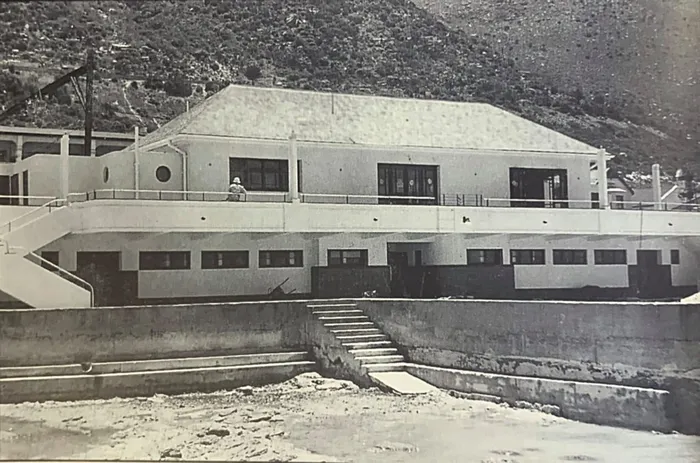Echoes of bygone beach days ring out at Brass Bell

An undated picture of the Kalk Bay pavilion. Picture: Kalk Bay Historical Association.
The Brass Bell in Kalk Bay has a history that dates back more than 80 years to when the site was home to a pavilion and swimming pool, according to the Kalk Bay Historical Association.
Originally, two pavilions were built on the site to serve bathers using Bishop's Pool, a natural rock pool named after Bishop Gray, who frequented the area in the 1860s.
The Dalebrook tidal pool, further up the line, was the first of the pools to be built in Kalk Bay. It was illegally built in 1903 as a private undertaking by Mr F B Steer of Douglas Cottage.
According to the association’s records, the foreshore from Dalebrook southwards to Kalk Bay, though rocky, had a more gradual slope and broader and longer stretches of sand. Bathing was possible in many places, but the area was monopolised by boats, and fish cleaning that had polluted the water.
Instead, swimmers took to the rock pools and gullies near the station, one of which became known as Bishop’s Pool as Bishop Gray had often bathed there.
In 1907, there were still no public bathing facilities, and in 1908, men's and women’s bathing screens, hangers, shower baths, and floor mats were provided.
In 1911, the Kalk Bay Muizenberg Municipality contracted Charles McGhie to formalise the walling of Bishop’s Pool thereby creating a long rectangular pool that bathers walked into over a sloping sand beach.
However, these early structures were destroyed by high tides. In response, a concrete pavilion was built in 1913 for £420 which became the foundation of what is now the Brass Bell Restaurant.
It was situated south of the railway footbridge (today’s subway entrance) and provided bathing cubicles for men and women, as well as freshwater showers and toilets.
However, the following year, facilities were bursting at the seams, and Mr Dellbridge built a second pavilion north of the railway footbridge, which included a tea room.
This became the new women’s pavilion while the first pavilion became the men’s pavilion. Both offered the same facilities of seven freshwater showers and toilets, except that the men’s was larger with 44 cubicles compared to the 24 for women.
Together they catered for 700 bathers a day.
In the same year, a low wall was built across the beach end of the pool to prevent sand from silting it.
In 1914, all bathing boxes that had stood against the rail embankment were removed to open up more beach space, and the city council built 60 metres of sea wall to prevent the sea from scouring the beach sand.
In 1905, the Cape Government Railways had built a 150-metre long and 5-metre-wide wooden sea-side platform, which allowed Kalk Bay to also boast of having a promenade in addition to two pavilions and a pool.
In 1922, a new square pool, named Kalk Bay Pool, was built onto the north side of Bishop’s Pool, substantially enlarging the area available for safe bathing. A new children’s pool was also built at the end of Bishop’s Pool.
During the 1930s, seawalls were built to protect the beach areas. In 1938, a sea wall was extended southwards to enclose a sand beach, and a new children’s pool was built to replace the former one.
These pavilions served many thousands of bathers until they were demolished in 1939, and a new pavilion, the third on this beach, opened on November 9, 1939.
It is this structure that forms the core of today’s Brass Bell Restaurant, which has leased the premises, once the tea room, since the early 1970s, when the pavilion and the station milk bar were renovated and rebuilt to form a restaurant.


